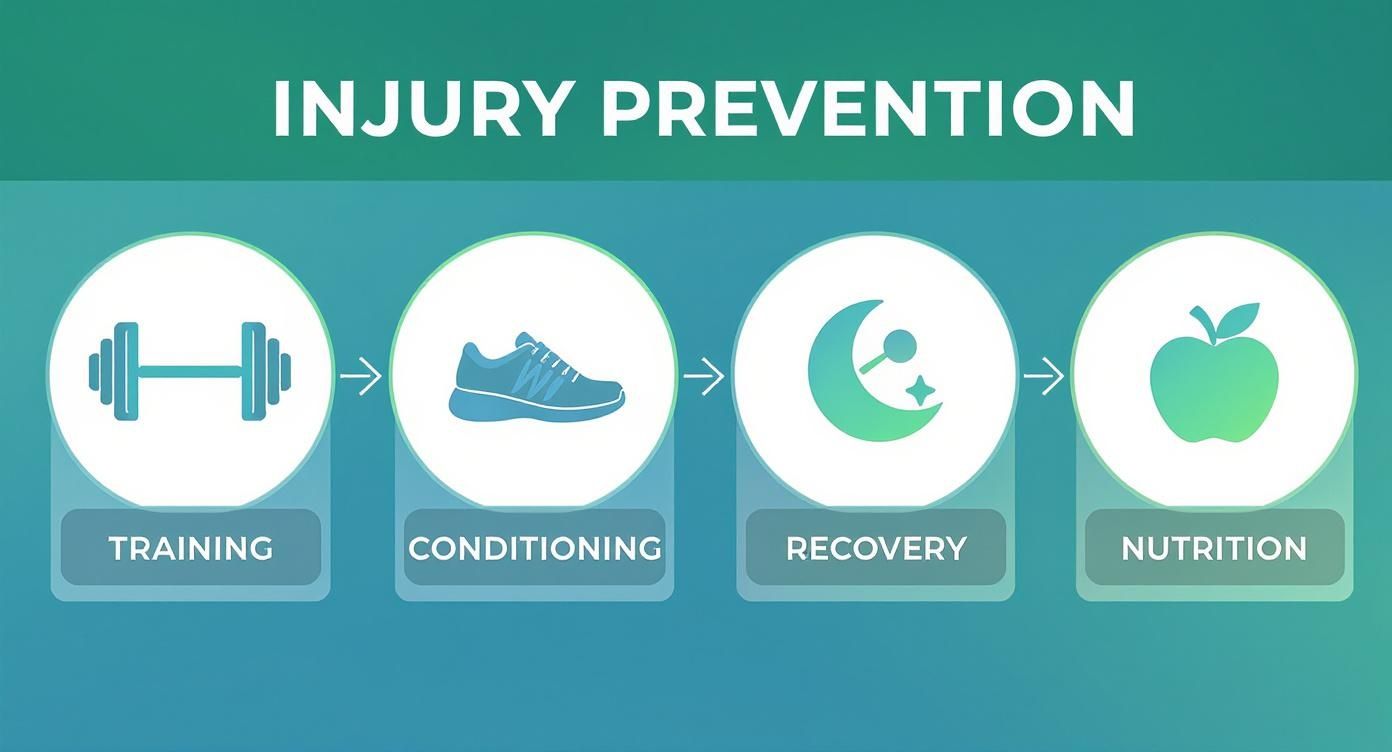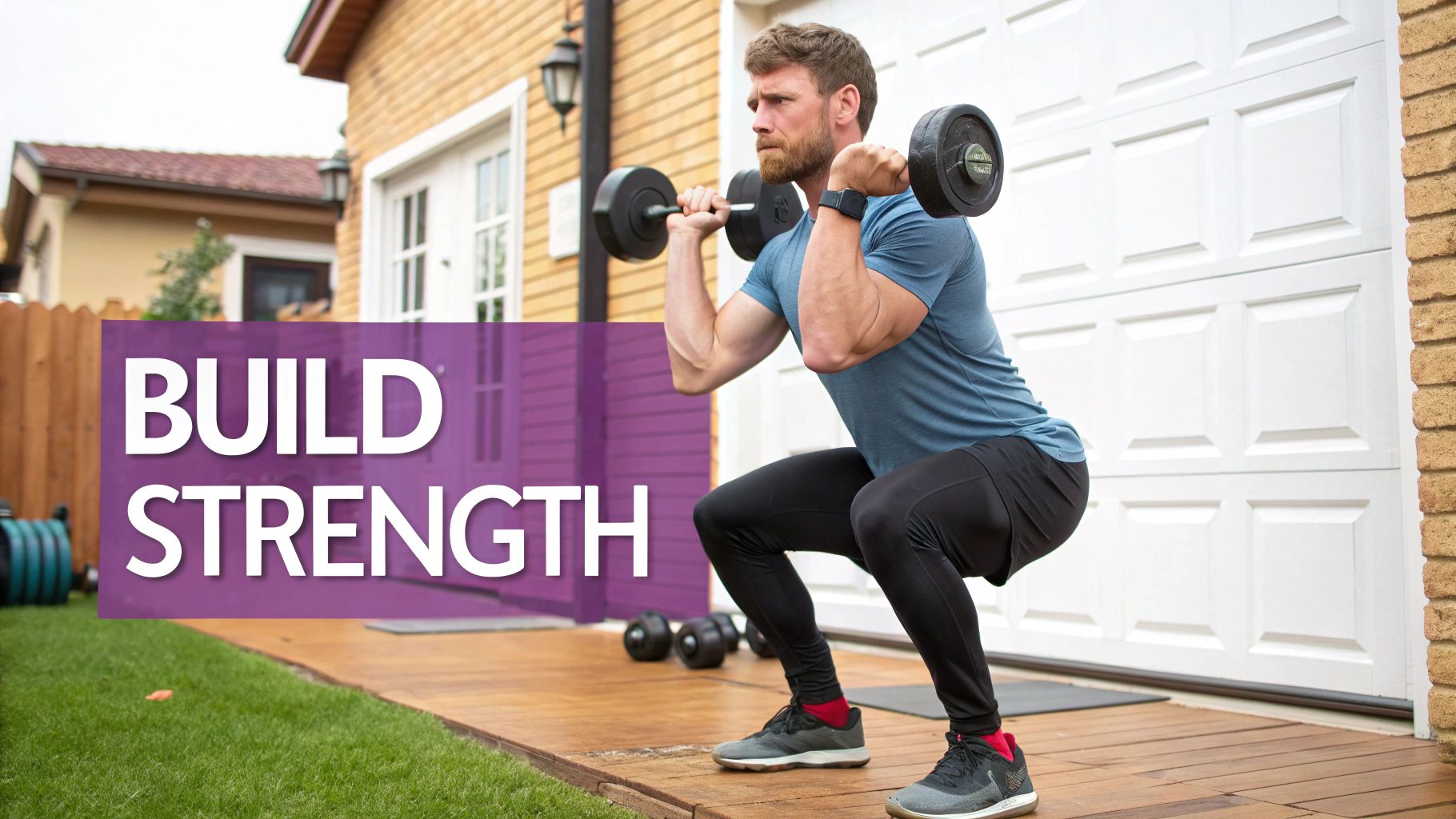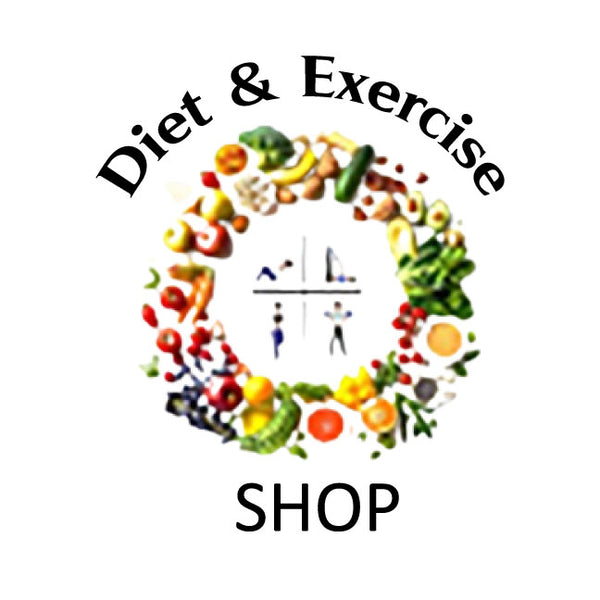
How to Prevent Sports Injuries and Stay in the Game
When it comes to sports, the best defense is a good offense. This means proactively building a body that's resilient enough to handle whatever you throw at it.
Staying injury-free isn't a secret trick. It’s a system built on smart training, proper conditioning, and listening to your body.
Building Your Foundation for Injury Prevention
The best way to deal with an injury is to make sure it never happens. This means focusing on the real-world habits that keep seasoned athletes in the game.
An effective strategy isn't just one thing. It's a blend of several key elements working in harmony.
This is a complete cycle of preparation, execution, and recovery. The core components are simple but powerful:
- Smart Training: Master the proper techniques for your sport and use the right gear. Our online shop, dietexerciseshop.com, offers top-tier equipment designed for safety and performance.
- Targeted Conditioning: Strengthen and stretch the specific muscles that power your movements. A versatile Resistance Band Kit is perfect for this.
- Strategic Recovery: Rest isn't optional. Giving your body the tools it needs to repair itself is non-negotiable for staying healthy.
- Mindful Nutrition: Fueling your body correctly provides the building blocks for muscle repair. Supplements like our Premium Whey Protein Isolate can be a game-changer.
A Holistic Approach to Staying Healthy
Thinking about injury prevention as a complete system is the only way it works. Wearing the right shoes is a fantastic start, but they won't do much if your muscles are weak or you’re running on empty.
You can dive deeper into this with our guide on the best running shoes for beginners, which explains why proper footwear is so critical.
Your greatest asset is a proactive mindset. Don't wait for pain to tell you something's wrong. Build daily habits that create a buffer against potential injuries.
This integrated approach isn't just theory. Research shows that comprehensive injury prevention programs deliver incredible results. One study found that a multi-faceted approach led to a 15% reduction in overall injuries.
If you're a data nerd, you can explore the full study on injury prevention programs to see the impact for yourself.
To make this easier to visualize, think of it in terms of four core pillars.
The Four Pillars of Injury Prevention
Here's a quick breakdown of the foundational strategies that work together to keep you healthy and performing at your peak.
| Pillar | Key Focus | Example Action |
|---|---|---|
| Smart Training | Quality of movement and proper equipment. | Filming your deadlift to check your form or getting fitted for running shoes. |
| Targeted Conditioning | Building strength and flexibility in sport-specific muscles. | Incorporating single-leg squats and hip bridges to support your knees. |
| Strategic Recovery | Active rest and muscle repair. | Using a foam roller on your quads and hamstrings after a tough workout. |
| Mindful Nutrition | Fueling for performance and recovery. | Eating a protein-rich meal within an hour of finishing your training session. |
By focusing on these foundational pillars, you're not just training for performance—you're building a durable body built to last.
Mastering Your Warm-Ups and Cool-Downs
Think of your warm-up as the opening act for your main performance. Jumping straight into a workout is a recipe for disaster.
A solid warm-up gradually wakes up your muscles, joints, and nervous system for the hard work to come.
This isn’t about holding a few static stretches. The key is focusing on dynamic movements that mimic what you're about to do.
Dynamic warm-ups get the blood flowing, raise your core body temperature, and improve your range of motion. For a complete routine, watch our video on Proper Warm-Up Techniques.
The Science Behind Smart Preparation
Sticking to evidence-based programs is a game-changer. Research shows that structured programs can slash the risk of certain injuries by up to 50%.
This visual illustrates the cycle of training, conditioning, recovery, and nutrition needed to stay in the game.

As you can see, injury prevention is a continuous process where every part supports the others. A balanced diet and exercise routine are key to achieving your fitness goals.
Why Your Cool-Down Matters Just as Much
Just as you ease into your workout, you need to ease out of it. Your cool-down helps your body transition from high gear back to a state of rest.
A proper cool-down brings your heart rate down gradually and kickstarts the recovery process. This is the perfect time for static stretches to improve flexibility and release muscle tension.
Think of your cool-down as an investment in your next workout. The better you recover today, the stronger you'll be tomorrow.
To step up your recovery, using the right tools makes a huge difference. A good High-Density Foam Roller is an invaluable tool for getting rid of muscle knots.
Using a foam roller allows you to perform self-myofascial release on key areas like your quads, hamstrings, and back, which seriously reduces soreness.
Strength Training to Bulletproof Your Body
Strength training is your secret weapon for preventing sports injuries. It's about forging a body that can handle the intense demands of your sport.
Think of it as building a natural suit of armor for your most vulnerable joints.

When you strengthen the muscles around your joints, you give them a powerful support system. That stability drastically cuts down your risk for common sprains and strains.
Building Your Body Armor with Smart Exercises
The fastest way to build resilience is with compound movements. These are exercises that engage multiple muscle groups at once, like squats, deadlifts, and overhead presses.
These movements build real-world, functional strength across your entire body. They teach your muscles to fire together as a single, coordinated unit.
Targeted exercises also have their place. If you have a weak link, like unstable shoulders, you need to zero in on it. This is where basic equipment makes a world of difference.
Building a resilient body is a proactive process. Don't wait for an injury to happen; strengthen your weaknesses before they become a problem.
With versatile tools, you can run a comprehensive program at home. This one-two punch of compound lifts and targeted work creates an injury-proof physique.
The Right Tools for a Resilient Body
You don’t need a commercial gym. A few key pieces of equipment from dietexerciseshop.com can unlock a huge range of exercises.
Here’s what we recommend for a solid at-home setup:
- An Adjustable Dumbbell Set: A total game-changer for adding weight to lunges, presses, and rows without cluttering your space.
- A Resistance Band Kit: Essential for waking up smaller, stabilizing muscles. A quality Resistance Band Kit is perfect for activation drills or adding a challenge to bodyweight moves.
With just these two items, you have everything needed to create a powerful injury-prevention routine that covers all your bases.
Form Is Everything
Let me be crystal clear: perfect form always comes first. Lifting with sloppy technique is one of the fastest tickets to the injured list.
Before adding weight, master the movement pattern itself. Start light and concentrate on slow, controlled reps.
For visual learners, seeing a lift broken down by an expert is a lightbulb moment. Check out our ultimate guide on proper lifting techniques on the Diet & Exercise YouTube channel for detailed instructions.
Remember, training smart will beat just training hard, every single time.
Fueling for Performance and Injury-Proofing Your Body
You can't out-train a bad diet. Nutrition is a crucial piece of the puzzle for staying off the sidelines.
What you put in your body directly dictates how it performs, repairs itself, and stands up to the stress of training.
Think of it this way: you wouldn't fill a race car with low-grade fuel. Your body is no different. It needs a smart mix of macronutrients and micronutrients.
This isn't about complicated diets. It's about making simple, intelligent choices that support your goals. Your diet and exercise habits must work together to achieve your fitness goals.
The Big Three: Your Macronutrient Blueprint
Your body relies on three key macronutrients—carbohydrates, proteins, and fats—to power you through workouts and handle repairs.
- Carbohydrates: Your body's go-to energy source. Eating carbs before you train tops off your glycogen stores.
- Protein: Essential for repairing and building muscle. Protein supplies the amino acids needed to patch up muscle fibers.
- Fats: Vital for hormone production and absorbing key vitamins, serving as a long-term energy source.
Get the balance wrong, and you're looking at slow recovery and a higher risk of getting hurt. For a detailed breakdown, check our guide to sports nutrition for endurance athletes.
Timing is Everything: When You Eat Matters
What you eat is important, but when you eat can be a game-changer for recovery.
A "recovery window" opens up right after your workout, typically within 30-60 minutes. During this time, your muscles are like sponges, ready to soak up nutrients.
Getting protein and carbs into your system during this window kickstarts the repair process, eases muscle soreness, and refills your tank.
This is where a high-quality supplement makes a real difference. A scoop of Premium Whey Protein Isolate delivers fast-digesting protein to start muscle repair immediately.
Don't overlook hydration. Being dehydrated can lead to fatigue and muscle cramps. Using an Electrolyte Hydration Mix during tough sessions replaces vital minerals, keeping your muscles firing.
Using Technology for Smarter Training
In athletics, data is your secret weapon. Wearable technology is now a serious tool that gives you a window into how your body is handling the stress of training.
It lets you make smart, data-driven decisions that can keep you off the sidelines.

This tech turns complex biological signals into simple insights. Metrics that used to require a sports science lab are now on your wrist, telling you when to push and when to pull back.
The blend of wearable tech and data analytics has become a massive part of injury prevention. It’s no surprise the global sports medicine market is projected to grow at a CAGR of 8.6% from 2024 to 2033.
Key Metrics You Should Track
Don't get lost in a sea of numbers. Focus on a few game-changing metrics that reveal your body's stress levels and readiness to perform.
- Training Load: The total stress from all your workouts. If this number keeps climbing without rest, you're on a fast track to burnout.
- Heart Rate Variability (HRV): Measures the variations between each heartbeat. A high HRV means you're recovered and ready. A low HRV is a warning sign to take it easy.
By keeping an eye on these two metrics, you can build a training schedule that perfectly balances hard work with smart recovery.
Putting Data into Action
How does this work in the real world? Imagine a runner deep into marathon training.
They notice on their fitness app that their HRV has been trending downward for three days straight. This is a classic red flag that their body isn't recovering properly.
Instead of stubbornly sticking to the schedule, they make a change. They swap a high-intensity workout for a light recovery jog.
By trusting the data, they avoided pushing their body over the edge and likely sidestepped a nasty strain or stress fracture.
That’s the power of this tech. It helps you see invisible warning signs before they become a full-blown injury.
Got Questions? Let's Talk Injury Prevention
Even seasoned athletes have questions about staying healthy. Being proactive and curious is what keeps you in the game.
First up: should you push through pain? The short answer is no. Learn to recognize the difference between the burn of a workout and the sharp pain of an injury.
Another question is about rest days. How many do you need? A good starting point is at least one or two full rest days each week. This is when your muscles repair and get stronger.
How Much Sleep Do I Really Need?
Sleep is your secret weapon for recovery. Studies show a direct link between a lack of sleep and a higher risk of injury.
For most athletes, 8-10 hours a night is the sweet spot for peak physical and mental recovery. When you're asleep, your body is working overtime to repair micro-tears in your muscles.
Are Young Athletes More Prone to Certain Injuries?
Absolutely. A young athlete's body is a work in progress. Their bones are still growing, which means their joints, muscles, and growth plates are vulnerable.
Growth plates are weaker than solid bone and can give under the stress of sports. This is why you see youth-related issues like Osgood-Schlatter disease.
The biggest issue is overuse. It accounts for roughly half of all injuries in young athletes. The key is balance—mixing structured sports with free play and enough downtime.
What Is the Best Diet for Injury Prevention?
There isn't a single magic diet, but the core principles are universal. Build your meals around key building blocks:
- Lean proteins to repair and build muscle, like those found in our Premium Whey Protein Isolate.
- Complex carbohydrates to fuel your workouts and replenish energy stores.
- Healthy fats to support joint health and keep hormones in check.
Don't overlook micronutrients like calcium and Vitamin D for strong bones. Staying hydrated and replacing lost minerals with an Electrolyte Hydration Mix is also non-negotiable.
At Diet & Exercise, we know that having the right gear is just as important as having the right knowledge. Our collection is specifically chosen to support you through every warm-up, workout, and recovery session.
